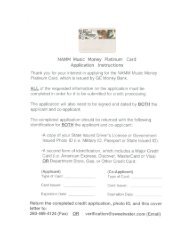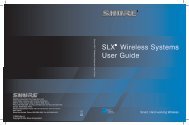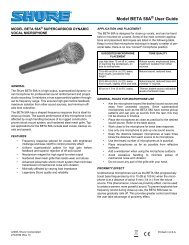Create successful ePaper yourself
Turn your PDF publications into a flip-book with our unique Google optimized e-Paper software.
Backing Track Functions<br />
Selecting the Backing Types<br />
(Style/Song/USB Memory Player)<br />
The GW-8 allows you to use the following three types of<br />
musical backing. To switch the backing type, use BACKING<br />
TYPE [STYLE], [SONG] and [USB MEMORY PLAYER].<br />
[STYLE] (p. 25)<br />
This backing uses the Music Styles. The GW-8 Style function<br />
automatically generates a backing with multiple instruments;<br />
simply choose one of a variety of Music Styles (Styles), then<br />
use your left hand to specify a chord. You can also choose<br />
Variations to change the backing in addition to the Intro,<br />
Main, and Ending backing types.<br />
Using only the drum part of a Style as the<br />
backing<br />
If you turn all of BACKING TYPE [STYLE], [SONG] and<br />
[USB MEMORY PLAYER] off, you’ll hear only the drum<br />
part of the currently selected Style. Just as when [STYLE] is<br />
on, you’ll be able to use the STYLE CONTROL buttons and<br />
VARIATION buttons to choose different variations.<br />
[SONG] (p. 27)<br />
You can use the recording function to record your own<br />
performance into the GW-8. Since a 16-track sequencer is<br />
built in, you can use multi-track recording to create a song by<br />
recording a different sound on each track. A song you’ve<br />
created can also be used as the backing for your keyboard<br />
performance.<br />
SMF data can be loaded into the user Song and played back.<br />
[USB MEMORY PLAYER] (p. 31)<br />
This allows you to play back audio files or SMF data that’s<br />
been saved on USB memory. You can use this playback as the<br />
backing for your keyboard performance.<br />
Adjusting the Tempo ([TAP TEMPO])<br />
You can’t adjust the tempo of audio data.<br />
1. Press [TAP TEMPO] three or more times at the desired<br />
interval.<br />
The tempo setting window will appear, and the tempo will<br />
be specified by the interval at which you pressed the<br />
button.<br />
You can also specify the tempo by pressing [TAP TEMPO] to<br />
access the tempo setting window, and then using the cursor<br />
buttons and VALUE dial to specify the tempo. Press [EXIT] to<br />
close the tempo setting window.<br />
Using the metronome<br />
1. Press [TAP TEMPO].<br />
The tempo setting window will appear.<br />
2. Use the cursor buttons to move the cursor to “Metronome,”<br />
and use the VALUE dial to turn it on.<br />
When you turn the metronome on, it will begin sounding.<br />
3. To stop the metronome, turn off “Metronome.”<br />
4. Press [EXIT] to return to the Main screen.<br />
For details on volume and other settings for the metronome,<br />
refer to “Using the Metronome” (p. 23).<br />
Adjusting the Volume Balance between<br />
Backing and Keyboard (BALANCE buttons)<br />
Use BALANCE [BACKING] and [KEYBOARD] to adjust the<br />
volume balance between the backing and your keyboard<br />
performance.<br />
If you press BALANCE [BACKING] and [KEYBOARD]<br />
simultaneously, the volume balance will return to its original<br />
value.<br />
If you’ve changed the volume balance, the button whose<br />
volume is higher will be lit.<br />
This setting cannot be stored.<br />
24
















